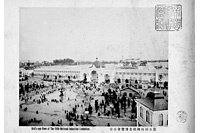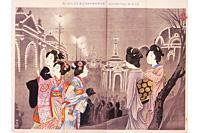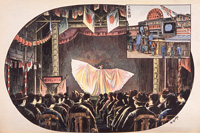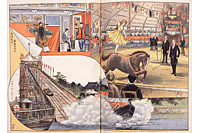Fifth National Industrial Exhibition
Last and largest national industrial exhibition
- Period
- : March 1, 1903 - July 31, 1903
- Venue
- : Osaka City (Tennoji, Imamiya)
- No. of visitors
- : 4,350,693
This was held in Osaka in 1903. Initially, the fifth National Industrial Exhibition had been planned for 1899. To prepare for participation in the Paris International Exposition of 1900 and the Glasgow International Exposition of 1901, however, the fifth National Industrial Exhibition had been postponed. There was great expectation for the success of the event, partly because many Japanese companies were expanding their markets actively following the victory of Japan in the Sino-Japanese War (1894 - 95), and because the railroad network had been extended almost nationwide. The venue area was more than double of that of the previous event; the event period was 153 days, the longest in the history of the National Industrial Exhibitions. This event was the last but the largest National Industrial Exhibition in Japan.
The venue contained the Agricultural Production Building, the Forestry Production Building, the Marine Production Building, the Industrial Building, the Machinery Building, the Educational Building, the Fine Art Building, the Transportation Building, and the Animal Building, as well as the Taiwan Building and the Foreign Samples Building (see photographs). Unlike temporary structures in the past expositions, the buildings were plastered. The Fine Art Building was subsequently used as Osaka Shimin Hakubutsukan (Osaka City Museum). As the second venue of the exposition, an aquarium was built in Sakai.
At the Foreign Samples Building, constructed as preparation for the holding of an international exposition in Japan in the future, the display of exhibits by foreign countries was permitted for the first time. More than 10 countries, such as the United Kingdom, Germany, the United States, France, and Russia, exhibited their items. The exhibits that made a strong impression of the coming of the new period were eight U.S. automobiles. It can be said that, even though it was just a domestic exposition, the event presented a step closer to the realization of an international exposition that Japan had long wished to hold.
The event was held even at night for the first time in the history of Japanese National Industrial Exhibitions, with illumination provided at the venue. A big fountain was illuminated with five colors, and the Obayashi Tower, fitted with an elevator, drew crowds. These items indicated that Japan had fully entered into the electric age. Also popular were entertainment facilities, including a water chute near the pond of Chausuyama, a merry-go-round, the World Panorama Building, the Wonder Building (featuring a fantastic dance performance using electric lamps and gunpowder, as well as demonstrating technologies regarding wireless telegraph, X-rays, and moving pictures), and a large-scale circus. The aquarium in Sakai was a permanent two-story building. After the end of the exposition, the facility was much loved as Sakai Suizokukan (Sakai Aquarium) by the people of the city. Many of the buildings were closed at night, but the event still drew many visitors even at night with its illumination and entertainment performance. As a result, the number of the visitors to the exposition was the largest since the beginning of the National Industrial Exhibitions in Japan.
While the original purpose was to promote domestic industries, the Japanese National Industrial Exhibitions began to shift their focus to the economic effects generated by the consumption and other activities by the visitors. Actually, the fifth National Industrial Exhibition brought Osaka City huge economic benefits. Thus, these events began to be regarded as an important measure for promoting city revitalization, further raising expectations that an international exposition would be held in Japan. Some people proposed that the sixth National Industrial Exhibition scheduled for 1907 should be held as an international exposition. Facing financial difficulties following the Russo-Japanese War, however, the sixth event was postponed with its cost-effectiveness for industrial promotion called into question, and was eventually cancelled. Subsequently, expositions were held only on a prefectural level. A national exposition was not held in Japan until the Osaka International Exposition of 1970 after the end of the Second World War.
- References:
Kuni, Takeyuki.: Hakurankai no jidai: Meiji seihu no hakurankai seisaku (Iwata shoin, 2005) <D7-H68>
Kuni, Takeyuki, Tokyo toritsu tanki daigaku.: Kindai nihon to hakurankai - Meiji seihu no naikoku kangyo hakurankai, bankoku hakurankai, kyoshinkai seisaku (Reports under Grants-in-Aid for Scientific Research from the Ministry of Education, 1999-2002) <Y151-H11610365>
Yoshida, Mitsukuni.: Bankoku hakurankai: Gijutsu bunmeishiteki ni Revised ed. (Nihon hoso shuppan kyokai, 1985) <D7-67>
Yoshida, Mitsukuni (ed).: Zusetsu bankoku hakurankaishi: 1851-1942 (Shibunkaku shuppan, 1985) <D7-66>
Yoshimi, Toshiya.: Toshi no doramaturugi: Tokyo sakariba no shakaishi (Kawade syobo shinsha, 2008) <EC122-J31>





